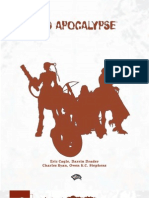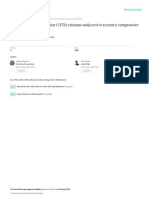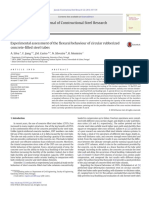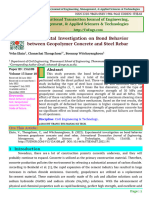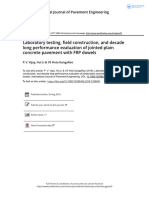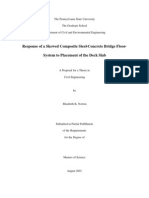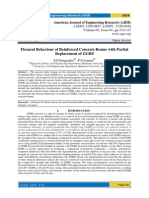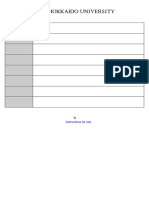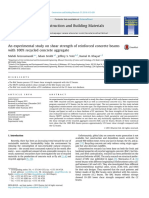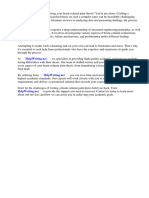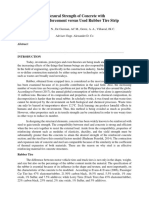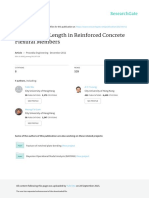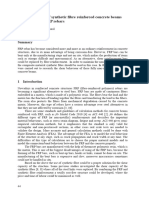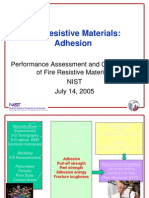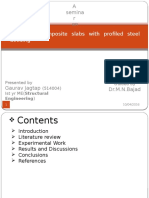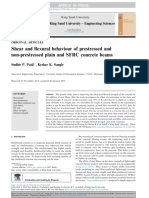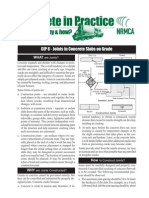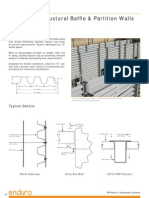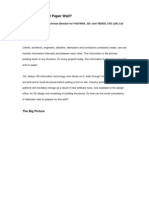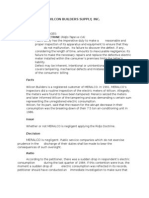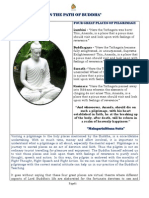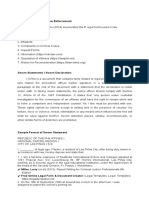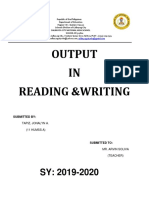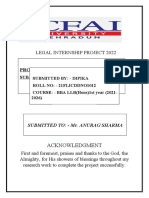Shrinkage-Compensating Concrete-Past, Present, and Future, Part 1
Shrinkage-Compensating Concrete-Past, Present, and Future, Part 1
Uploaded by
Loay Al-SabbaghCopyright:
Available Formats
Shrinkage-Compensating Concrete-Past, Present, and Future, Part 1
Shrinkage-Compensating Concrete-Past, Present, and Future, Part 1
Uploaded by
Loay Al-SabbaghOriginal Description:
Original Title
Copyright
Available Formats
Share this document
Did you find this document useful?
Is this content inappropriate?
Copyright:
Available Formats
Shrinkage-Compensating Concrete-Past, Present, and Future, Part 1
Shrinkage-Compensating Concrete-Past, Present, and Future, Part 1
Uploaded by
Loay Al-SabbaghCopyright:
Available Formats
1/10/2013
1
ACI
WEB SESSIONS
Shrinkage-Compensating
ConcretePast, Present, and
Future, Part 1
ACI Fall 2012 Convention
October 21 24, Toronto, ON
ACI
WEB SESSIONS
Seth Roswurmgraduated with a Bachelors of Science
in May 2012 as theOutstanding Senior in Civil
Engineering with a 4.0/4.0 GPA at theUniversity of
Oklahoma. Heis presently pursuing a masters degree
in structural engineering studying therestrained
expansion characteristics of CalciumSulpoAluminatecements at the
Donald G. Fears Structural Engineering Laboratory at TheUniversity
of Oklahoma. Seth is a member of Chi Epsilon and Tau Beta Pi honor
societies.
Behavior of Type K Shrinkage-
Compensating Concrete Under Various
Forms of Mechanical Restraint
Seth Roswurm
University of Oklahoma
Acknowledgments
University of Oklahoma
Fears Structural Engineering Laboratory
Advisor: Dr. Chris Ramseyer
Sponsor: CTS Cement Manufacturing
Topics
Background/Theory
Method
Results
Conclusions
Restraint of Slabs: ACI 223
Slab-on-ground surrounded by existing:
infinite restraint
there can be no movement
...high compressive stress in concrete but
may provide little compensation
1/10/2013
2
Expansive slab to be
cast in center
Restraint of Slabs: ACI 223
...high compressive
stress
but little
compensation
Existing mature slabs react
against new slab
Expansive slab to be
cast in center
Does Total Restraint Exist?
Classical Mechanics Hookes Law
Applied force must be accompanied by
material deformation (whether large or
small)
Concrete is elastic over a small range and
therefore cannot be a perfect boundary
condition
Concrete Elastic Displacement
Initial
Condition
Loaded Condition
+
Elastic Deformation
1/10/2013
3
Steel Elastic Displacement
Initial
Condition
Loaded Condition
+
Elastic Deformation
Concrete Material Expansion
Concrete/Steel Interaction: Initial Concrete/Steel Interaction: Displaced
Concrete/Steel Interaction: Forces Equivalent Stiffness
Axial stiffness defined by:
Result: Steel area required is roughly equal to a
group of (4) 5/8 bars
Additionally, test with (4) and (4) bars
Provides 36% to 44% range, respectively
1/10/2013
4
The Test
Reactions
modeled as steel rods
Expansive slab
modeled as column
Mixes
(Lbs. per cubic yard)
Mixes
(Lbs. per cubic yard)
30% Komp
19% Komp
17% Komp
15% Komp
30% Komp
19% Komp
17% Komp
15% Komp
1/10/2013
5
Instrumentation
GeoKon VWSG:
Unrestrained 6x12 Cylinder
GeoKon VWSG imbedded in center:
30% Komp
19% Komp
15% Komp
157 (15% Komp)
GeoKon (15% Komp)
GeoKon (19% Komp)
157 (19% Komp)
GeoKon (30% Komp)
157 (30% Komp)
1/10/2013
6
Restrained 6x12 Cylinder
GeoKon VWSG imbedded in center:
cylinder
=
878
= 0.17%
Restrained 6x12 (15% Komp)
878 (15% Komp)
Restrained 6x12 (15% Komp)
Test Frames
Somat eDAQ
GeoKon Loggers
1/2 Frame
5/8 Frame
3/4 Frame
Wet Curing Condition
PVC Water J acket
Wet Curing Condition
Columns Curing with
PVC Water J ackets
1/10/2013
7
Dry Curing Condition
Water J ackets
Removed
5/8 in.
3/4 in.
1/2 in.
5/8 in.
3/4 in.
1/2 in.
Increase in load with
increasing rod stiffness
5/8 in.
3/4 in.
1/2 in.
5/8 in.
3/4 in.
1/2 in.
5/8 in.
3/4 in.
1/2 in.
1/10/2013
8
15% Komp
30% Komp
19% Komp
17% Komp
15% Komp
30% Komp
19% Komp
17% Komp
15% Komp
30% Komp
19% Komp
17% Komp
5/8 in. (287 lb)
3/4 in. (562 lb)
1/2 in. (209 lb)
5/8 in. (287 lb)
3/4 in. (562 lb)
1/2 in. (209 lb)
Increase in expansion with
decreasing rod stiffness
5/8 in. (340 lb)
3/4 in. (360 lb)
1/2 in. (392 lb)
1/10/2013
9
5/8 in. (480 lb.)
3/4 in. (361 lb)
1/2 in. (529 lb)
15% Komp (209 lb.)
30% Komp (529 lb)
19% Komp (392 lb)
15% Komp (287 lb)
30% Komp (480 lb)
19% Komp (340 lb)
15% Komp (562 lb)
30% Komp (361 lb)
19% Komp (360 lb)
Instrumentation Conclusions
GeoKon VWSG converges consistently with
ASTM-standardized tests
VWSG generates smoother, more complete
data sets than length-comparator tests
Overall behavior better characterized due to
finer interval of readings
Instrumentation Conclusions
VWSG 6x12 specimens less vulnerable to
environmental variation:
Higher thermal mass than ASTM bar tests
Lower surface-area-to-volume ratio than ASTM bar
tests
1/10/2013
10
Material Conclusions
Bracketing the stiffness problem:
Frame Size: 5/8
Material Conclusions
Bracketing the stiffness problem:
Frame Size: 5/8
Stiffness Variance: 36% 44%
Theoretical Midpoint
44% Stiffer
36% Softer
Material Conclusions
Large increase in restraint stiffness does not
cause a large gap in shrinkage compensation
All column expansion data sets are tightly clustered
A very stiff boundary condition will not prevent
shrinkage-compensating expansion
Type K shrinkage compensating concrete is not
sensitive to a mature concrete boundary condition
Material Conclusions
Compressive stress is accompanied by
significant expansion
In general, higher loads are generated by
stiffer restraint
Both load and expansion are influenced by
amount of pre-compression in the columns
Work in progress: perform a range of tests with
carefully controlled low pre-compression values
Questions?
You might also like
- d20 ApocalypseDocument96 pagesd20 ApocalypseJosiah Scott Arthur100% (31)
- A Raisin in The Sun DLPDocument10 pagesA Raisin in The Sun DLPJane Macababbad Tungcul100% (1)
- Load Bearing Bahaviour of Cast in Shear Dowels PDFDocument7 pagesLoad Bearing Bahaviour of Cast in Shear Dowels PDFToan Pham100% (1)
- Covariances in The Determination of Conventional Mass: Short CommunicationDocument3 pagesCovariances in The Determination of Conventional Mass: Short CommunicationJaime Barranco100% (1)
- 2007d 4 Service Live Design (Adv PDFDocument65 pages2007d 4 Service Live Design (Adv PDFHyunkyoun JinNo ratings yet
- 22Document8 pages22Husseinali HusseinNo ratings yet
- Behaviour of Axially Loaded Columns Strengthened With Carbon Fiber Reinforced PolymersDocument22 pagesBehaviour of Axially Loaded Columns Strengthened With Carbon Fiber Reinforced Polymersbariq89100% (1)
- BioRes 07 2 B Popil Overview Edge Compression Buckling 1006Document30 pagesBioRes 07 2 B Popil Overview Edge Compression Buckling 1006SubtabNo ratings yet
- Concrete-Filled Steel Tubular CFTS Columns Subject PDFDocument14 pagesConcrete-Filled Steel Tubular CFTS Columns Subject PDFRicky GunawanNo ratings yet
- 3864Document127 pages3864Zamir MearNo ratings yet
- Model Tests On Bearing Capacity and Accumulated Settlement of A Single Pile in Simulated Soft Rock Under Axial Cyclic LoadingDocument16 pagesModel Tests On Bearing Capacity and Accumulated Settlement of A Single Pile in Simulated Soft Rock Under Axial Cyclic LoadingHuang BenNo ratings yet
- Tensile Characterization of Glass FRP Bars: S. Kocaoz, V.A. Samaranayake, A. NanniDocument8 pagesTensile Characterization of Glass FRP Bars: S. Kocaoz, V.A. Samaranayake, A. NanniTavio TavioTavioNo ratings yet
- Concrete-Filled Steel Tubular CFTS Columns SubjectDocument14 pagesConcrete-Filled Steel Tubular CFTS Columns SubjectJoão VictorNo ratings yet
- 2018 - FRC - Influence of Test Methodology On The Applicability of Test Results of Fibre Reinforced Concrete For DesignDocument10 pages2018 - FRC - Influence of Test Methodology On The Applicability of Test Results of Fibre Reinforced Concrete For DesignJuhász KPNo ratings yet
- Silva 2016Document14 pagesSilva 2016sali8439443No ratings yet
- Design of Composite Slabs With Profiled Steel Deck PDFDocument16 pagesDesign of Composite Slabs With Profiled Steel Deck PDFsourabh mahanaNo ratings yet
- 13A10BDocument10 pages13A10Bdmt7nzztcmNo ratings yet
- RC T Beams Strengthened To Shear With Carbon Fiber CompositesDocument12 pagesRC T Beams Strengthened To Shear With Carbon Fiber CompositesJackson Oliveira Dos SantosNo ratings yet
- صحت سنجیDocument13 pagesصحت سنجیnima sarNo ratings yet
- An Experimental Study On Bond Strength of Reinforced Steel in High Volume Fly Ash ConcreteDocument14 pagesAn Experimental Study On Bond Strength of Reinforced Steel in High Volume Fly Ash Concretemohamed ellithyNo ratings yet
- ReportDocument22 pagesReportFaisal MohammedNo ratings yet
- Aljanabi 2020 IOP Conf. Ser. Mater. Sci. Eng. 871 012004Document11 pagesAljanabi 2020 IOP Conf. Ser. Mater. Sci. Eng. 871 012004alaa hassoonNo ratings yet
- Design of Composite Slabs With Profiled Steel Deck PDFDocument16 pagesDesign of Composite Slabs With Profiled Steel Deck PDFPanha MenhNo ratings yet
- Synophsis of Geopolymer and Geopolymer ConcreteDocument165 pagesSynophsis of Geopolymer and Geopolymer Concreteabhi singhNo ratings yet
- Author's Accepted Manuscript: Ijmecsci.2014.12.011Document25 pagesAuthor's Accepted Manuscript: Ijmecsci.2014.12.011Abdul Haris SiregarNo ratings yet
- Finite Element Modeling of RC Beams Externally Strengthened by FRP Composites (2000) - Thesis PDFDocument104 pagesFinite Element Modeling of RC Beams Externally Strengthened by FRP Composites (2000) - Thesis PDFJulio Humberto Díaz RondánNo ratings yet
- Response of A Skewed Composite Steel-Concrete Bridge Floor-System To Placement of The Deck SlabDocument28 pagesResponse of A Skewed Composite Steel-Concrete Bridge Floor-System To Placement of The Deck SlabSajib DasNo ratings yet
- Uhpc Id51Document8 pagesUhpc Id51Khams TaghaNo ratings yet
- Geopolymer Concrete To Reduce The Anthropogenic Greenhouse Gas Emissions Associated With The Concrete and Construction IndustryDocument3 pagesGeopolymer Concrete To Reduce The Anthropogenic Greenhouse Gas Emissions Associated With The Concrete and Construction IndustrylotushNo ratings yet
- Flexural Behaviour of Reinforced Concrete Beams With Partial Replacement of GGBSDocument9 pagesFlexural Behaviour of Reinforced Concrete Beams With Partial Replacement of GGBSAJER JOURNALNo ratings yet
- Shear Behaviour of Geopolymer Concrete Beams Without StirrupsDocument31 pagesShear Behaviour of Geopolymer Concrete Beams Without StirrupsMartin MainaNo ratings yet
- Zhang D. Experimental and Analytical Investigation of Crack Spacing and Width For OverlaidDocument31 pagesZhang D. Experimental and Analytical Investigation of Crack Spacing and Width For Overlaiddmt7nzztcmNo ratings yet
- An Experimental Study On Shear Strength PDFDocument9 pagesAn Experimental Study On Shear Strength PDFParthiban PNNo ratings yet
- Dowel Bar Size and Spacing For Rigid Pavements PDFDocument8 pagesDowel Bar Size and Spacing For Rigid Pavements PDFTim Lin100% (1)
- Nonlinear Finite Element Modeling of FRP-wrapped UHPC ColumnsDocument18 pagesNonlinear Finite Element Modeling of FRP-wrapped UHPC ColumnsJamal Eddine HamiltonNo ratings yet
- Nonlinear Finite Element Modeling of FRP-wrapped UHPC ColumnsDocument18 pagesNonlinear Finite Element Modeling of FRP-wrapped UHPC ColumnsJamal Eddine HamiltonNo ratings yet
- Nonlinear Finite Element Modeling of Concrete Confined by Fiber Composites. Amir M. Elsevier 2000Document18 pagesNonlinear Finite Element Modeling of Concrete Confined by Fiber Composites. Amir M. Elsevier 2000FELIX C.GNo ratings yet
- 1179 FinalDocument21 pages1179 Finaltsitsi bizaNo ratings yet
- Beam Column Joint ThesisDocument5 pagesBeam Column Joint Thesiskarriegarcianorthlasvegas100% (2)
- Materials 15 06944 v3Document22 pagesMaterials 15 06944 v3Nathanael Basana HisarNo ratings yet
- Experimental Study of Solid Cylinder, Hollow Cylinder and Hollow Cylinder With PVC ConfinementDocument31 pagesExperimental Study of Solid Cylinder, Hollow Cylinder and Hollow Cylinder With PVC ConfinementTabish IzharNo ratings yet
- Flexural Strength of Concrete With Steel Reinforcement Versus Used Rubber Tire StripDocument6 pagesFlexural Strength of Concrete With Steel Reinforcement Versus Used Rubber Tire StripAna Camille De GuzmanNo ratings yet
- Plastic Hinge Length in Reinforced Concrete Flexural MembersDocument10 pagesPlastic Hinge Length in Reinforced Concrete Flexural MembersHenry HoyosNo ratings yet
- Li Et Al. (2019) - Cyclic Test and Numerical Study of Precast Segmental Concrete Columns With BFRP and TEEDDocument20 pagesLi Et Al. (2019) - Cyclic Test and Numerical Study of Precast Segmental Concrete Columns With BFRP and TEEDsbanerjeeNo ratings yet
- The Creep Behaviour of AdhesivesDocument100 pagesThe Creep Behaviour of AdhesivesMahzanJoharNo ratings yet
- Fang, Lundgren, Chen, Zhu-Corrosion Influence On Bond in Reinforced ConcreteDocument9 pagesFang, Lundgren, Chen, Zhu-Corrosion Influence On Bond in Reinforced ConcretepinarinciNo ratings yet
- 002 JKP SPDocument5 pages002 JKP SPPeter Karoly JuhaszNo ratings yet
- Effective Width Criteria For Composite BeamsDocument7 pagesEffective Width Criteria For Composite BeamsJoey JoejoeNo ratings yet
- Fire Resistive Materials: AdhesionDocument30 pagesFire Resistive Materials: AdhesionChethan RaviNo ratings yet
- Design of Composite Slabs With Profiled Steel DeckingDocument30 pagesDesign of Composite Slabs With Profiled Steel Deckinggaurav jagtapNo ratings yet
- 1-s2.0-S101836391600009X-main ArtDocument8 pages1-s2.0-S101836391600009X-main Arttest3No ratings yet
- Thesis On Steel Fibre Reinforced ConcreteDocument8 pagesThesis On Steel Fibre Reinforced Concretedenisemillerdesmoines100% (2)
- EUROCKPaper MC FinalDocument6 pagesEUROCKPaper MC Finalsaurabh rawatNo ratings yet
- Failure Modes and Failure Mechanisms of Fiber Reinforced Polymer Composite Bridge DecksDocument10 pagesFailure Modes and Failure Mechanisms of Fiber Reinforced Polymer Composite Bridge Decksalemteka97No ratings yet
- Polymers: Long-Term Flexural Behaviors of GFRP Reinforced Concrete Beams Exposed To Accelerated Aging Exposure ConditionsDocument21 pagesPolymers: Long-Term Flexural Behaviors of GFRP Reinforced Concrete Beams Exposed To Accelerated Aging Exposure ConditionsjRNo ratings yet
- P.J.bourne-Webb, Et.l - (2006) - Elastic Plastic Flexure of Embedded Retaining WallsDocument8 pagesP.J.bourne-Webb, Et.l - (2006) - Elastic Plastic Flexure of Embedded Retaining WallsAnonymous PibYPghNo ratings yet
- Nipetal 2013-Ultimatebehaviourofsteelbracesundercyclicloading PDFDocument48 pagesNipetal 2013-Ultimatebehaviourofsteelbracesundercyclicloading PDFMohamed AhmedNo ratings yet
- Compression Testing of Concrete Cylinders vs. CubesDocument13 pagesCompression Testing of Concrete Cylinders vs. CubesJAZPAKNo ratings yet
- Conferinta C60 - Geobrugg - Comparatie CO2 SCURTDocument4 pagesConferinta C60 - Geobrugg - Comparatie CO2 SCURTDvmLemNo ratings yet
- 99-s38 - On Evaluation of Rotation Capacity For Reinforced Concrete BeamsDocument9 pages99-s38 - On Evaluation of Rotation Capacity For Reinforced Concrete BeamsbllldNo ratings yet
- Bellow Using FemDocument9 pagesBellow Using FemSonam Behl KambojNo ratings yet
- Ultimate Limit State Analysis and Design of Plated StructuresFrom EverandUltimate Limit State Analysis and Design of Plated StructuresNo ratings yet
- Joints in Concrete SlabsDocument2 pagesJoints in Concrete SlabsmutyokaNo ratings yet
- Eduro D Structural Baffle - Partition Walls Data SheetDocument2 pagesEduro D Structural Baffle - Partition Walls Data SheetLoay Al-SabbaghNo ratings yet
- Use of UBC1997Document62 pagesUse of UBC1997Loay Al-Sabbagh100% (2)
- How Solid Is That Paper Wall?: by Richard Dobson, Technical Director For FASTRAK, 3D+ and TEDDS, CSC (UK) LTDDocument8 pagesHow Solid Is That Paper Wall?: by Richard Dobson, Technical Director For FASTRAK, 3D+ and TEDDS, CSC (UK) LTDLoay Al-SabbaghNo ratings yet
- Hemodynamic RevisiDocument2 pagesHemodynamic RevisiLiaLeunuraNo ratings yet
- Observation ChecklistDocument7 pagesObservation Checklistapi-446049984No ratings yet
- De Thi Khao Sat HSG 12 Mon Tieng AnhDocument8 pagesDe Thi Khao Sat HSG 12 Mon Tieng AnhbuitinhNo ratings yet
- St. William's Academy Bulanao, Inc. Senior High School DepartmentDocument3 pagesSt. William's Academy Bulanao, Inc. Senior High School DepartmentLyka FrancessNo ratings yet
- Probex Strategy Rayhanah BDocument12 pagesProbex Strategy Rayhanah BNaila BanglanNo ratings yet
- JR ResumeDocument1 pageJR ResumeRico SuaveyNo ratings yet
- Write The Past Simple Form of The Following Verbs and Write Their Meaning in SerbianDocument3 pagesWrite The Past Simple Form of The Following Verbs and Write Their Meaning in SerbianIvana KandićNo ratings yet
- Meralco Vs Wilcon BuildersDocument2 pagesMeralco Vs Wilcon BuildersBAROPSNo ratings yet
- Internal Conflict and Governance (Kumar Rupesinghe (Eds.) ) (Z-Library)Document321 pagesInternal Conflict and Governance (Kumar Rupesinghe (Eds.) ) (Z-Library)AntenehMeluNo ratings yet
- Desirable Corporate Governance: A CodeDocument16 pagesDesirable Corporate Governance: A CodesiddharthanandNo ratings yet
- 13 Day Program IndiaBhutan2014Document14 pages13 Day Program IndiaBhutan2014jambayTDNo ratings yet
- The Old Testament BackgroundDocument2 pagesThe Old Testament BackgroundVipindas VNo ratings yet
- CR 92-Lesson 3 Legal Forms Sworn Statement-DeclarationDocument6 pagesCR 92-Lesson 3 Legal Forms Sworn Statement-DeclarationJoebell VillanuevaNo ratings yet
- Bullinger, E. W. - Appendixes To The Companion BibleDocument670 pagesBullinger, E. W. - Appendixes To The Companion Bibleproofreader100% (1)
- 13-Angle PropertiesDocument13 pages13-Angle PropertiesSameh SalahNo ratings yet
- Ics Case 6Document24 pagesIcs Case 6Pui YanNo ratings yet
- Output IN Reading &writing: Republic of The Philippines Department of Education Region VIII - Eastern VisayasDocument10 pagesOutput IN Reading &writing: Republic of The Philippines Department of Education Region VIII - Eastern VisayasScepter PorlaresNo ratings yet
- Endocrine Disorders QuizDocument14 pagesEndocrine Disorders QuizDoreen ClaireNo ratings yet
- Emotional Intelligence PresentationDocument33 pagesEmotional Intelligence PresentationMansha YousafNo ratings yet
- Legal Internship Project 2022Document20 pagesLegal Internship Project 2022Ankush ShuklaNo ratings yet
- 2020 Ipalpiti BrochureDocument76 pages2020 Ipalpiti BrochureiPalpitiNo ratings yet
- Customer (Transaction) Dispute Form To, Yes Bank LTD Card Operations One Indiabulls Park, Yes Bank Towers, 3 Floor, Plot No. 14, 3Rd Main Road, Ambattur Industrial Estate, CHENNAI - 600058Document1 pageCustomer (Transaction) Dispute Form To, Yes Bank LTD Card Operations One Indiabulls Park, Yes Bank Towers, 3 Floor, Plot No. 14, 3Rd Main Road, Ambattur Industrial Estate, CHENNAI - 600058RavikiranNo ratings yet
- Grade 10 ReviewerDocument2 pagesGrade 10 ReviewerLanie De la TorreNo ratings yet
- Sample Chapter5Document5 pagesSample Chapter5zoltan2014No ratings yet
- GUIDELINES FOR PREPARATION OF OIL SPILL RESPONSE CONTINGENCY PLAN OISD - GUIDELINES-200 Amended Edition October 2002 - OISD-GDN-200Document36 pagesGUIDELINES FOR PREPARATION OF OIL SPILL RESPONSE CONTINGENCY PLAN OISD - GUIDELINES-200 Amended Edition October 2002 - OISD-GDN-200Vaishnavi JayakumarNo ratings yet
- 2017 Book QualityInNuclearMedicineDocument455 pages2017 Book QualityInNuclearMedicineHarley Alejo MNo ratings yet
- TransCAD - Exercise Session 1-4Document3 pagesTransCAD - Exercise Session 1-4Vincy VergheseNo ratings yet
